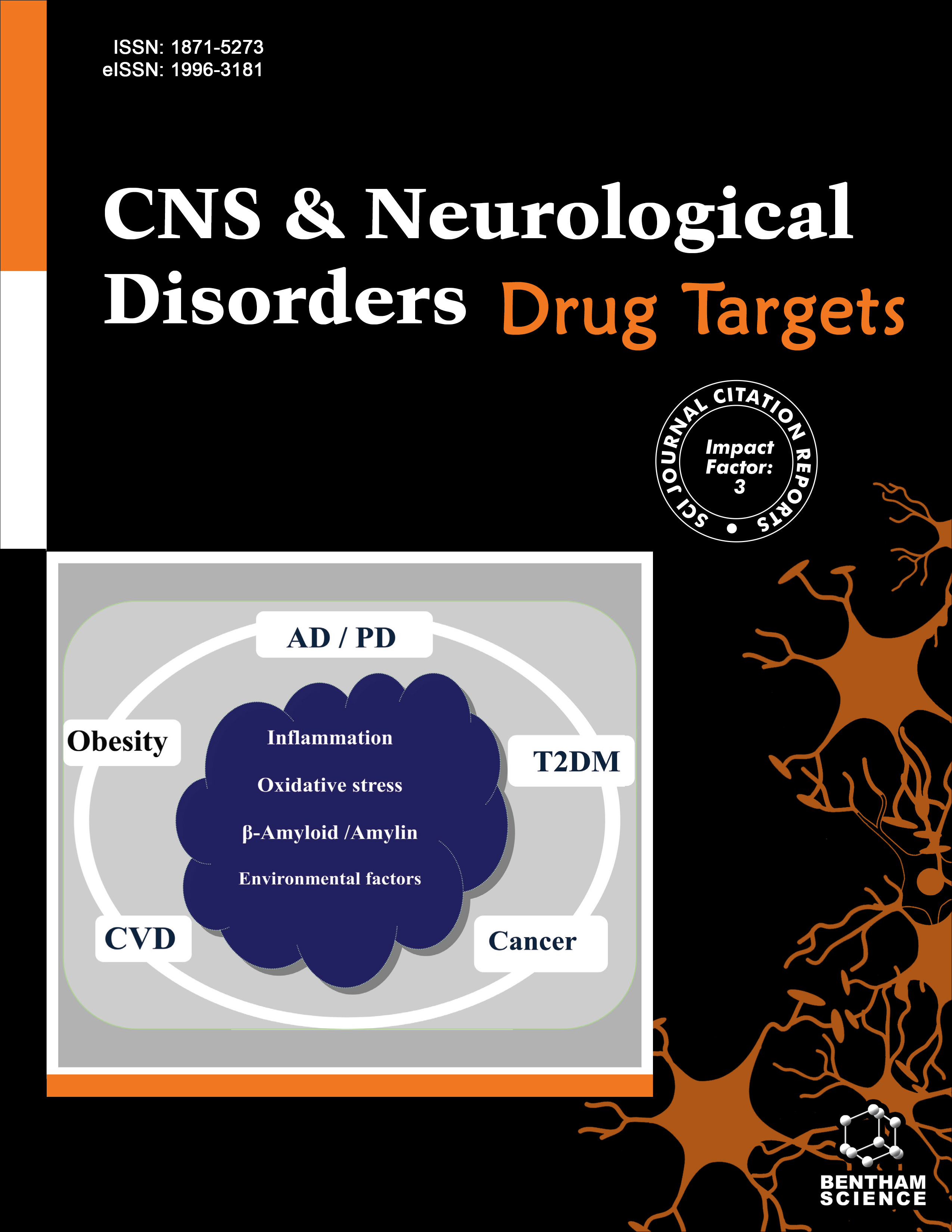- Home
- A-Z Publications
- CNS & Neurological Disorders - Drug Targets (Formerly Current Drug Targets - CNS & Neurological Disorders)
- Previous Issues
- Volume 20, Issue 1, 2021
CNS & Neurological Disorders - Drug Targets (Formerly Current Drug Targets - CNS & Neurological Disorders) - Volume 20, Issue 1, 2021
Volume 20, Issue 1, 2021
-
-
Improvement of a Novel Proposal for Antioxidant Treatment Against Brain Damage Occurring in Ischemic Stroke Patients
More LessAuthors: Sofía Orellana-Urzúa, Gonzalo Claps and Ramón RodrigoThe underlying mechanism of cerebral injury occurring in patients with acute ischemic stroke involves a key pathophysiological role of oxidative stress. Thus, reactive oxygen species are related to the development of brain edema, calcium overload, mitochondrial dysfunction, excitotoxicity, iron release and inflammation. Nevertheless, although experimental studies have tested the use of antioxidants as an adjuvant therapy i Read More
-
-
-
Exploring the Various Aspects of Brain-Derived Neurotropic Factor (BDNF) in Diabetes Mellitus
More LessAuthors: Eshita Sharma, Tapan Behl, Vineet Mehta, Arun Kumar, Dhruv Setia, Md. S. Uddin, Gokhan Zengin and Sandeep AroraBrain-Derived Neurotrophic Factor (BDNF) serves as a modulator for neurotransmitters by participating in neuronal plasticity, essential for their growth and neuronal survival. It also shows a wide range of expression patterns in the systemic and peripheral tissues; thereby, its biological actions are not just limited to the CNS but may a vital role in peripheral disorders, such as Diabetes Mellitus (DM). Platelets serve as one Read More
-
-
-
Nanotechnology: Its Application in Treating Neurodegenerative Diseases
More LessAuthors: Falaq Naz and Yasir H. SiddiqueNeurodegenerative diseases such as Alzheimer’s, Parkinson’s and Huntington disease have serious concern due to its effect on the quality of life of affected persons. They have some limitations at diagnostic as well as the treatment level. Introducing nanotechnology, for the treatment of these diseases may contribute significantly to solve the problem. There are several treatment strategies for the neurodegenerative diseases, Read More
-
-
-
Deciphering the Role of Aberrant Protein Post-Translational Modification in the Pathology of Neurodegeneration
More LessAuthors: Sadat Shafi, Archu Singh, Paras Gupta, Pooja A. Chawla, Faizana Fayaz, Anjali Sharma and Faheem H. PottooNeurodegenerative diseases, including Alzheimer’s Disease (AD), Parkinson’s Disease (PD), Amyotrophic Lateral Sclerosis (ALS) and Huntington's Disease (HD), are characterized by progressive neuronal dysfunction and death. Recent studies have established detrimental modifications in the structure and function of brain proteins, which stimulate their aggregation, misfolding and deposition in and around the neurons an imp Read More
-
-
-
MicroRNA-Targeted Signaling Pathways in the Autism Spectrum Disorder: Implications for Early Detection and Targeted Therapy
More LessBackground & Objective: Autism Spectrum Disorders (ASD) is known as a neurodevelopmental disorder showing communication impairments and unusual patterns of behavior. Presently, it seems that ASD frequency is on the increase. Therefore, diagnostic tools that help detect the disease in the early stages can be very useful in better management of the disease. Recent studies demonstrate that miRNAs as novel biomarkers Read More
-
-
-
Atorvastatin Prevents the Neuron Loss in the Hippocampal Dentate Gyrus Region through its Anti-Oxidant and Anti-Apoptotic Activities
More LessBackground: Atorvastatin is a member of statins, which has shown positive vascular effects, anti-oxidant, anti-platelet, and anti-apoptotic properties. Objective: In this study, we hypothesized that atorvastatin could prevent the neurons lost in the hippocampal dentate gyrus region after transient global Ischemia/Reperfusion (I/R) through its anti- oxidant and anti-apoptotic activities. Method: Twenty-four male Wistar rats, 1 Read More
-
-
-
Efficacy and Tolerability of Lacosamide for Focal Epileptic Patients: Study from Epilepsy Clinic in Makkah
More LessAuthors: Amal Alkhotani, Hanadi Abualula, Yasser Almatrafi, Sawsan Ghomiem and Alkhotani AlaaBackground: Lacosamide is characterized by its novel dual mode of action on account of its structural components; its molecule contains a functional amino acid that selectively and slowly promotes the inactivation of voltage-gated sodium channels. Objective: This study aims to assess the effectiveness and tolerability of Lacosamide with respect to its use in the treatment of focal epileptic patients. Methods: This retrosp Read More
-
Volumes & issues
-
Volume 24 (2025)
-
Volume 23 (2024)
-
Volume 22 (2023)
-
Volume 21 (2022)
-
Volume 20 (2021)
-
Volume 19 (2020)
-
Volume 18 (2019)
-
Volume 17 (2018)
-
Volume 16 (2017)
-
Volume 15 (2016)
-
Volume 14 (2015)
-
Volume 13 (2014)
-
Volume 12 (2013)
-
Volume 11 (2012)
-
Volume 10 (2011)
-
Volume 9 (2010)
-
Volume 8 (2009)
-
Volume 7 (2008)
-
Volume 6 (2007)
-
Volume 5 (2006)
Most Read This Month
Article
content/journals/cnsnddt
Journal
10
5
false
en

Most Cited Most Cited RSS feed
-
-
A Retrospective, Multi-Center Cohort Study Evaluating the Severity- Related Effects of Cerebrolysin Treatment on Clinical Outcomes in Traumatic Brain Injury
Authors: Dafin F. Muresanu, Alexandru V. Ciurea, Radu M. Gorgan, Eva Gheorghita, Stefan I. Florian, Horatiu Stan, Alin Blaga, Nicolai Ianovici, Stefan M. Iencean, Dana Turliuc, Horia B. Davidescu, Cornel Mihalache, Felix M. Brehar, Anca . S. Mihaescu, Dinu C. Mardare, Aurelian Anghelescu, Carmen Chiparus, Magdalena Lapadat, Viorel Pruna, Dumitru Mohan, Constantin Costea, Daniel Costea, Claudiu Palade, Narcisa Bucur, Jesus Figueroa and Anton Alvarez
-
-
-
- More Less

